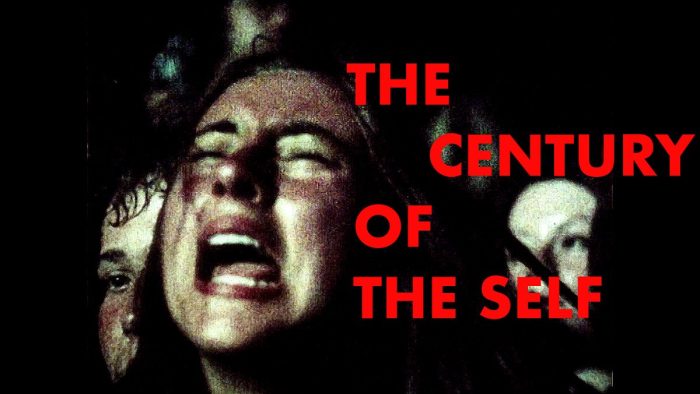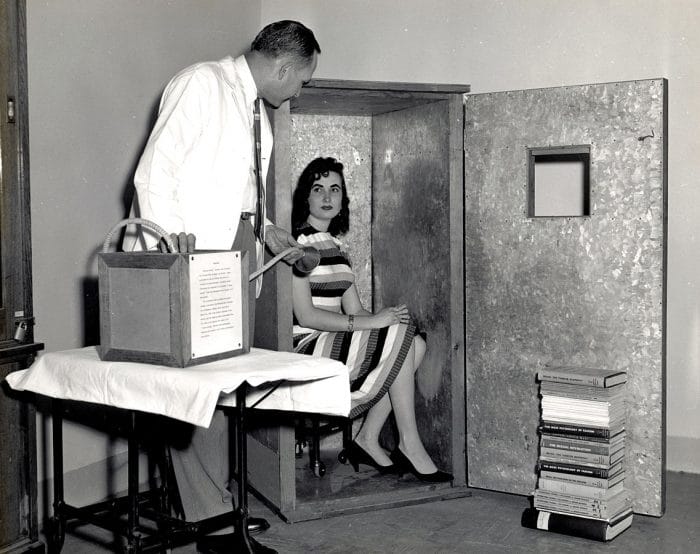Cesura III
Short piece based on a recent piano improvisation.
Performed during a snowy winter evening in New Hampshire’s White Mountains.
Short piece based on a recent piano improvisation.
Performed during a snowy winter evening in New Hampshire’s White Mountains.

In The Century of the Self, a trailblazing documentary series for the BBC in 2002, Adam Curtis explores how psychoanalysis begat the advertising/marketing techniques that transformed Western society into a consumerist hellscape (my words) from the mid- to late-20th century. If you haven’t seen it, go ye forth.
Greg and I have been watching Adam Curtis films for many years, and while we can always find something to bitch about, his ideas are powerful and, in my world, mostly correct. As such, they’ve melded with my thinking and writing. (Très dangereux!)
We recently released the first Doctor Body EP. Now, Doctor Body is a project with vocals, but it’s not a project about vocals. It’s improvisatory, it’s weird, it’s experimental, and it’s NOT about singing a song. You can check it out if you want to see what I mean:
Naming projects where the music revolves around the vocals is generally a pretty easy task: some bit from some song stands out, and that becomes the name. Or there’s some overarching theme that just calls out to be the name. But a Doctor Body release has nothing like that. It needs a name that comes from the id, just like its music. Which brings me back to psychoanalysis and the Century of the Self.
While I won’t make Adam Curtis’s full argument here, the general gist of the series is that Freud’s nephew, Edward Bernays, began to realize in the 1920s that psychology and psychoanalysis could be used not just to manipulate the individual, but to manipulate the masses as well, thus laying the groundwork for the teeming evil that is corporate marketing today. Once the ball start rolling in this direction, it didn’t stop.
A powerful figure in this history is called Wilhelm Reich, a disciple of Freud’s in the 1920s who split off from Freud when he challenged his view of psychoanalysis. For both Freud and Reich, human beings were driven by primitive animal instincts. They differed, however, on what to do with these instincts. Freud thought our unconscious minds were a seething pit of violence, and they should be repressed.
For Reich, these unconscious forces were the best part of people, and it was their repression by society that made people dangerous and unpredictable. Not only that, the driving force at the center of humans was the libido, a wildly powerful energy. If humans were able to release this energy in its pure form, they would be happy and powerful. Not to get too racy, but people should be having insane orgasms all the time to be mentally and emotionally healthy.
This was a problem for the Freud clan. By the 30s, the Freudian branch of psychoanalysis was dominant, and led by Anna Freud, who was a virgin and against sexuality. So Wilhelm Reich was cast out of the psychoanalysis community. As many European societal cast-offs were wont to do at the time, he ended up moving to the USA.

Shortly after, he became convinced that he had discovered the source of libidinal energy, which he called “orgone energy.” He could capture orgone energy*, he thought, by building Farraday cages and other machines that could pull the energy from the environment and concentrate it. He called these machines “orgone accumulators.”
He was eventually arrested by federal authorities because he claimed to be curing cancer with his orgone accumulators. He died in prison, completely cast out by the psychological establishment.
But although his orgone accumulators couldn’t cure cancer, ironically his ideas would experience a resurgence that would lead to a cancer of their own — libidinally-charged, hyper-individual advertising techniques, and the death of the counter-culture movement in favor of a radical individualism that became a radical consumerism. Or, so says Adam Curtis.
But what does this have to do with Doctor Body, you ask?
Doctor Body is the musical outlet where both Greg and I get to put our conscious minds away, and let our unconscious and subconscious minds drive the bus. We try to throw away our song-writing and compositional techniques and let the powerful forces have free rein.
Music is, in itself, a powerful and primal force. So in our ideal world, we, the musicians of Doctor Body, would be channeling this powerful force in its raw form. To do this, we could really use a machine to help. An orgone accumulator.
So yeah, there you go. The connections may be under the surface and not so obvious, but they’re strong, and you can find them if you look. Really, there couldn’t be a more perfect Doctor Body title!
* Also interesting and fun — orgone as a concept went on to be co-opted by many insane and/or dishonest people, including Sherry Shriner, the head of a reptilian alien conspiracy cult. Orgone wielded by her followers saved people from countless alien attacks, including an entire Super Bowl! If this sounds fun to you, check out the Sherry Shriner season of The Opportunist podcast.

When it comes to picking out where sounds originate, our ears are blisteringly fast and extremely accurate. But there are limitations. For example, lower frequencies (starting around 800 Hz and certainly below 200 Hz) are difficult to localize while frequencies over 1600 kHz are much easier to pinpoint. Also, the location of narrow band signals (like sine waves) is more difficult to perceive than those with lots of rich harmonic content. This is especially true in the frequency range of vocal intelligibility (between 500 Hz and 4 kHz).
Takeaway #1: Higher-pitched sounds with strong transients and stochastic spectral components are more easily localized and therefore have more options in terms of physical movement. They can move further and faster with greater effect.
When sounds move through space, their dynamic and emotional impact increases, but not all 3D motion is created equal. In order to be perceived as a single, coherent movement, sounds circling a listener must take more than ~250ms to make the journey. If they move faster than that, the source will appear to oscillate and become disorienting – which, of course, could be used to creative effect…
Takeaway #2: The physical movement of sound adds impact and energy, but a little goes a long way. Often a slow, gentle, local movement is more than enough to breathe life into your mix.
We have an inherent tendency to connect aural events to coincidental visual acts. Everyone has experienced this watching musicians perform – the sound of an amplified guitar may be coming from amplifiers sitting at the sides of the stage but our ears and eyes make us feel as if the sound is coming directly from the guitar itself – especially when we’re watching from a distance.
Perhaps this is the primary reason it doesn’t feel right to hear a drumset panning side to side? Even when we can’t see the source, our brains expect physical positioning to match our real world experience.
Takeaway #3: Understand the role each and every musical element plays in the construction of your mix and use those observations for creative good.
Timbre describes the spectral components of a single musical object or group of objects over time and, as with rhythm and harmony, the savviest composers can build meaningful connections by manipulating these relationships. Spatialization deals with the dimension of individual events, their relationship in physical space, and their relationship TO the space itself. That said, movement of sound through space is not an intrinsic quality of the sound.
Takeaway #4: Working in Dolby Atmos offers you opportunities to craft new connections and build meaningful relationships between the places individual musical elements inhabit. Not sure where to start? Try experimenting with contrast…
Moving a boring sound around in space will not make it less boring. However not all musical elements are meant to be exciting on their own. (Ever play the french horn in a Sousa march?) Consider the psychological impact of the musical intent and the role elements can play together – in combination.
Takeaway #5: Connect elements of similar intent and activity to clearly defined regions of physical space. Note that “connect” could suggest pitting elements against each other to create contrast.
When you hear a stereo recording of a dinner party, the crowd sounds like a single wash of sound. It’s nearly impossible to separate individual voices and conversations – this is the Cocktail Effect. Reducing the points of origin creates spatial masking which essentially helps us “glue” elements together a stereo mix, but elements separated in space also become separate and distinct in our perception.
Takeaway #6: While the spatial separation can “un-glue” your mix, it also allows you to control the direction of the listener’s focus and attention, thereby opening up creative possibilities.
Knowing the limitations of our ears can be EXACTLY the thing we need to create novel effects that engage and excite our listeners. Or it could be key to building a subtly expanded version of a well-loved stereo mix. Either way, the key to crafting effective spatial mixes is understanding those cognitive limits so you can use them to your artistic advantage.

I’ve been working on a very exciting web project — and for myself, not a client. For years now, Greg and I have been unhappy with the way releasing music works today. Not that it’s ever been perfect, but the business model of music is beyond imperfect at this point, and has reached a state that’s unsustainable for actual musicians.
So, we’ve always asked, what are a couple of tech-savvy musicians to do?
Years of ideas recently coalesced into something that we’re both very excited about — Wax and Leather, our tiny label/collective, will become a new way of releasing music that centers around the Fediverse, with some Indieweb principles sprinkled in for good measure.
Both Greg and I have found Mastodon to be a delightful online community, and I’m inspired by the decentralized model of the internet. I truly believe that we should own and control our creative products, even if that means things are a little messier.
So consider this post both a test of some new technologies we’re implementing, as well as my way of saying hello to this new project. I’m so excited to see where it leads.
Originally posted at https://alisonwilder.net/building-wax-and-leather/